Fig. 30.1
AP pelvis X ray of a right displaced femoral neck fracture
Plain radiographs with anteroposterior and lateral are sufficient to diagnose fracture in 98 % of cases. MRI is a low-radiation, high sensitivity and high specificity alternative when there is a high suspicion of fracture without conclusive findings on X-ray [81]. Treatment plan and outcome measures are correlated with displaced vs. non-displaced fracture features [82]. Eighty-five percent of femoral neck fractures are displaced at the time of diagnosis [24].
Non-displaced [83] or valgus impacted femoral neck fractures are generally treated with percutaneous pinning using a cannulated screw system (Fig. 30.2) [84]. Fixation with a sliding hip screw construct is another option for patients with femoral neck fractures. Despite the improved biomechanical stability with a sliding hip screw, most surgeons still use multiple cannulated screws for fixation of nondisplaced femoral neck fractures [85]. Patients can bear weight as tolerated after surgery and should be followed with serial radiographs to evaluate union [86, 87].
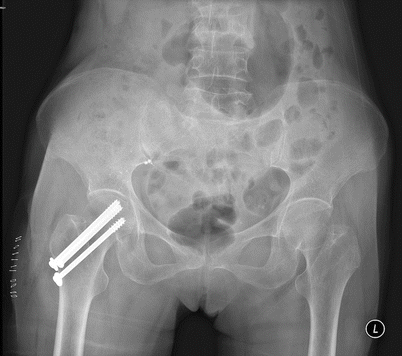

Fig. 30.2
AP pelvis X ray of percutaneous screws for fixation of a valgus impacted femoral neck fracture
There is a high risk of complications treating non-displaced fractures non-operatively. Rates of subsequent displacement range from 19 to 46 % [88–90]. Ultimately, these complications lead to worse outcomes overall than operative treatment. Thus, non-operative treatment should be reserved for those patients whose comorbidities make them very poor candidates for surgery, or non-ambulatory patients in a palliative care setting. Additionally, patients may elect to try non-operative treatment, but should be made aware of the alternatives [91].
Displaced femoral neck fractures are typically treated with hemiarthroplasty or total hip arthroplasty (Fig. 30.3). These procedures eliminate the risk of nonunion and fixation failure by using a prosthesis to bridge the joint space. Prostheses may be cemented or uncemented. Cemented femoral components may offer a decreased risk of intraoperative fracture and improved postoperative function over many uncemented components; however, comparative studies are not available for current generation uncemented systems [92–95]. These procedures are performed with the patient in a lateral position through either the lateral or posterior approach to the hip.
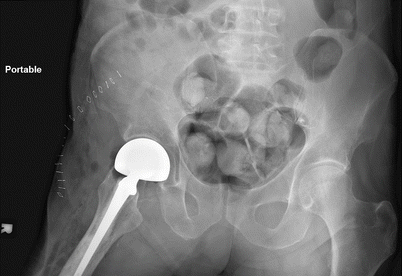

Fig. 30.3
AP pelvis X ray of a bipolar hemiarthroplasty for treatment of a displaced femoral neck fracture
The anterior approach is becoming more popular with surgeons because the exposure goes between muscle planes instead of through muscles. This approach is just now being studied in patients with total hip for osteoarthritis and may lead to a quicker recovery, decreased dislocation rate and decreased hospital stay [96]. Because of these promising results, this has translated to surgeons performing anterior approach for replacement surgery for fracture of the femoral neck [97]. The downside of the anterior approach is the need for a specialized operative table and the learning curve associated with the procedure [98]. The selection of procedure and implant type depends on surgeon experience, patient demographics, baseline function, and functional goals.
In unipolar hemiarthroplasty, the femoral neck and head are replaced by a non-modular implant. The modularity of bipolar hemiarthroplasty is thought to provide an advantage over the unipolar design. In bipolar hemiarthroplasty, an inner head articulates with a shell that in turn articulates with the acetabulum. In theory, this reduces wear and acetabular protrusion (femoral head migration into the pelvis) [99–102]. The modularity of a bipolar system allows the surgeon to test a variety of head/neck options in order to optimize stability. Despite these theoretical advantages, results are comparable with unipolar hemiarthroplasty [103, 104].
Total hip arthroplasty has been shown to have better outcomes for treatment of displaced femoral neck fractures in cognitively intact patients [105]. This comes at a risk of a higher dislocation rate [106]. Total hip arthroplasty is a longer and more complex procedure, and may have higher cost [107]. Although the procedure is more complex than hemiarthroplasty or percutaneous screws, 30-day mortality is low at 2.4 % [108]. Long term mortality and reoperation are low at 12 % and 5 % respectively. All of these data compare favorable to other methods of treatment. Rates of complication are understandably higher for secondary total hip arthroplasty to revise failed internal fixation [94, 109–111].
Summary
Nondisplaced femoral neck fractures should be treated with fixation using cannulated screws or a sliding hip screw and displaced femoral neck fractures in the elderly should be treated with replacement, either hemi or total hip arthroplasty. This decision is based on age, activity level and cognitive status of the patient [112–116]. Patients with pre-existing hip arthritis may also benefit from total hip arthroplasty [117–118].
Intertrochanteric Fractures
Intertrochanteric fractures are extracapsular, proximal metaphyseal fractures between the greater and lesser trochanter. In older patients, these injuries are predominantly due to low-energy trauma such as falls from standing height [119, 120]. The greater and lesser trochanters and the intertrochanteric region are sites of extensive muscle attachment, and fractures in this region are subject to considerable stress. Stable anatomic reduction and fixation are the paramount challenges of treating fractures in this functionally essential region [121, 122].
Non-operative treatment is reserved for patients with very low baseline function or very short life expectancies where medical palliation is adequate to control pain. Patients should be quickly mobilized to an upright position to minimize the risks of prolonged bedrest [123].
Operative fixation of intertrochanteric hip fractures is the standard of care. For stable fractures, which are either nondisplaced or displaced but a stable fracture pattern, a sliding hip screw is often preferred (Fig. 30.4a, b) [124, 125]. Sliding hip screws are designed to provide dynamic compression across the fracture to enhance stability and healing. If additional rotational stability is required, an additional screw can be placed in the femoral neck, parallel to the sliding screw system [126]. If possible, a closed reduction to anatomic position is achieved under fluoroscopy. Otherwise, open reduction is performed. The sliding screw system is placed using a lateral approach to the proximal femur. Guide wires placed under fluoroscopy are used to direct the screw in the correct position, and a plate is placed over the screw and secured to the femur [24, 127]. The typical mode of failure is cutout, which occurs in 4–7 % of patients. Reoperation is required in around 4 % of patients [24].
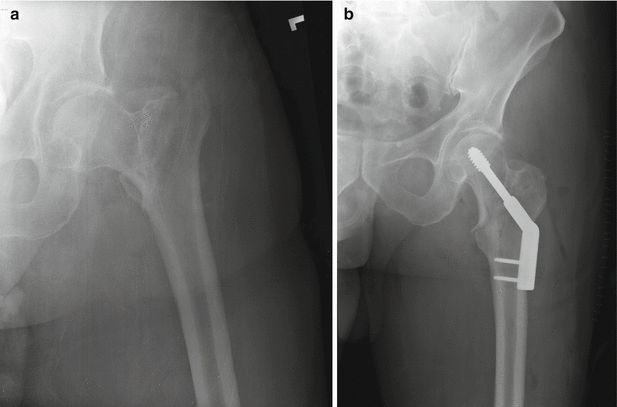

Fig. 30.4
(a, b): Pre (a) and Post (b) operative radiograph of a stable intertrochanteric hip fracture fixed with a sliding hip scew
For unstable fractures, an intramedullary device should be chosen to avoid excessive settling of the fracture (Fig. 30.5a, b) [128, 129]. The intramedullary approach requires a small incision over the proximal femur, marked with a guide wire under fluoroscopy. The nail is stabilized by an interlocking screw or blade extending into the femoral neck and head [130, 131]. This design provides linear compression across the fracture and the nail itself provides a buttress for the fracture to settle against. Nails vary in length, curvature, and diameter. Care must be taken to select the implant that will optimally reduce and stabilize the patient’s fracture [24].


Fig. 30.5
(a, b): Pre (a) and Post (b) operative radiograph of a stable intertrochanteric hip fracture fixed with a sliding hip scew
The definition of an unstable intertrochanteric hip fracture is debatable. In a retrospective study [132] of over 4400 patients identified in the NSQIP database, the only differences between patients treated with an intramedullary implant and an extramedullary implant was a lower rate of urinary tract infection (5.5 % vs. 9 %) and shorter postoperative hospital stay (5.4 days vs. 6.5 days) in favor of intramedullary implants. The authors rationalized this by citing the decreased soft tissue dissection in patients who received an intramedullary nail. They concluded that the decreased hospital cost for postoperative length of stay justifies the cost of using an intramedullary implant over a sliding hip screw.
After fixation of both stable and unstable intertrochanteric fractures, patients can begin weight-bearing as tolerated with a walker or crutches [133].
Subtrochanteric Fractures
Subtrochanteric fractures are less common than femoral neck and intertrochanteric fractures, but are a significant surgical challenge. These fractures occur in the proximal femur, distal to the lesser trochanter by up to 5 cm (Fig. 30.6). In elderly patients, the majority of subtrochanteric fractures are due to a simple fall [134, 135]. Due to enormous compressive, tensile, and torsional stresses in the region, deformation of the fracture segments is common. Often the proximal segment is deformed by the action of the hip flexors and abductors. The distal segment is subject to the action of adductors and knee extensors. Furthermore, the region is poorly vascularized, posing another obstacle to successful union [24].


Fig. 30.6
AP femur X ray of a left subtrochanteric hip fracture
A unique pattern of subtrochanteric fractures associated with bisphosphonate therapy has emerged in recent years. These are short, oblique fractures of the metaphyseal junction showing lateral cortical thickening and a medial cortical spike (Fig. 30.6). Patients can report prodromal symptoms prior to the fracture event. The proposed mechanism behind this is impaired healing of a stress reaction in the subtrochanteric region due to the bisphosphonate-induced inhibition of osteoclasts, which are normally required for fracture remodeling [136]. Patients who have been on bisphosphonate medication for 5 years or more are at increased risk for subtrochanteric or femoral shaft fractures [137]. However, patients taking bisphosphonates have a decreased risk of osteoporotic fractures, such as vertebral or more proximal femur fractures [138]. It is recommended that any patient on bisphosphonates should be evaluated with radiographs for stress fractures. [139].
All subtrochanteric fractures are treated operatively unless a severe co-morbidity precludes this. Operative treatment is typically with intramedullary nail (Fig. 30.7) [134, 140]. The same percutaneous approach for intramedullary nailing is used as was described for intertrochanteric fractures. Reduction is achieved under fluoroscopy or by an open approach and the nail inserted in the prepared canal. Most nailing systems will offer a choice of locking mechanisms, with a cephalomedullary locking device preferred in an unstable, osteoporotic fracture or any fracture without an intact lesser trochanter. A single large lag screw, or two smaller screws directed into the femoral head may offer added protection of the femoral neck in osteoporotic patients [141]. Otherwise, a standard greater trochanter to lesser trochanter oblique trochanteric locking screw can be placed through the nail [142].
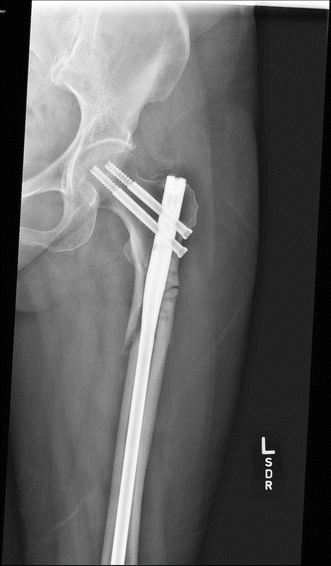

Fig. 30.7
AP femur X ray of an intramedullary nail for treatment of a left subtrochanteric hip fracture
Patients are made weight-bearing as tolerated after fixation with an intramedullary nail. Subtrochanteric hip fractures, as with other fractures around the hip joint, are associated with significant morbidity and mortality. Although they comprise a minority of proximal femoral fractures, these fractures are typically complex to treat and may be associated with an underlying pathologic cause, such as bisphosphonate use [143].
Mortality After Hip Fractures
Unfortunately, mortality after hip fracture is surprisingly high. It is clear that hip fractures are truly a surgical problem as the early mortality is almost double compared to non operative treatment of hip fractures [144]. Richmond et al. [145] reviewed 830 patients with hip fractures and found the highest mortality was within the first 3 months. Younger patients (age <85) also had a higher mortality, as were patients with a higher ASA classification. The in-hospital morality was 3 %. 1-year mortality rates in multiple studies have varied, but estimate a 30 % 1-year mortality. This is higher for cognitively impaired patients (50 %) and lower for cognitively intact patients (12 %) [24].
More than the fracture itself, the broken hip is a marker for declining functional and physiologic status. This is evident because the most common causes of death after hip fracture is not a complication from the broken bone, but circulatory disease, followed by complications of dementia. The risk of mortality in hip fracture patients is three times higher than in the general population [146].
In a recent study of over 4300 patients identified from NSQIP database, 30-day mortality after hip fracture was approximately 6 %. Age greater than 80 years, ASA class, dependent functional status, history of cancer and male gender were predictive of short-term mortality [147].
Return to Functional Status
Return to baseline ambulatory status and living situation is dismal after hip fracture. Sixty-percent of patients lose a level of ambulatory mobility at 1-year, i.e., community ambulators return as household ambulators after hip fracture surgery. Patients who are younger than 85 years, lower ASA or have a lower pre operative ambulatory status (low demand), are more likely to return to their baseline function [148]. Seventy-five percent of independent community ambulators are able to return to their pre-injury living status [58].
Summary
Despite advances in orthopaedic implants, mortality and outcomes after hip fracture are largely unchanged. This is mainly because a broken hip is a marker of overall declining health, not simply a broken bone.
Acetabular Fractures [132–143]
Acetabular fracture patterns in the elderly are different and often more complicated than in the younger population (Fig. 30.8). This is because of poor bone quality, which leads to more comminution and femoral head impaction, both of which can impact the ability to accurately repair these fractures [149]. In certain instances, fracture characteristics are predictive of early failure, such as impaction of the superior acetabular dome [150].


Fig. 30.8
AP pelvis X ray of a displaced right acetabular fracture
Evaluation of these patients in the emergency department should parallel the evaluation of the hip fracture patient. Radiographic studies should include an AP pelvis and Judet (obturator and iliac oblique) radiographs, as well as a CT scan with coronal and sagittal reconstructions. The technology of three-dimensional imaging has improved our understanding of these fractures and can be a useful teaching tool.
The best method of treatment of acetabular fractures in the elderly population is controversial. Patients are living longer [151] and enjoying a more active lifestyle. Clinicians likely agree that elderly patients should be defined by a physiological rather than chronological age. Treatment of acetabular fractures in the elderly population needs to be individualized with consideration of fracture pattern, activity level, and medical comorbidities [152].
Non operative Management
Consensus has been that nonoperative treatment of displaced acetabular fractures in the elderly leads to poor results; however, these reports are substantially flawed by lack of validated functional outcome data, short follow-up duration, and use of outdated treatment, such as prolonged traction or external fixation [153–157]. Spencer [156] presented a report of a cohort of 25 patients older than 65 years who were treated nonoperatively. The author had difficulty assessing types of fractures because of inadequate radiographs. The exact outcome measurements could not be determined despite the author’s conclusion that 16 patients had satisfactory results and 30 % had unacceptable results. Matta [153] reported similar results in a series of eight patients treated nonoperatively. The overall study population had only 12 patients older than 50 years. Two patients (25 %) were reported to have poor results. The clinical outcome used was a non-validated, modified scoring system originally used to study outcomes of acrylic hip prostheses [153] (Fig. 30.9).
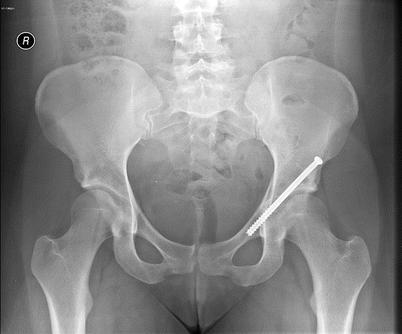

Fig. 30.9
AP pelvis X ray of a percutaneously treated acetabular fracture
Comparison of Operative Versus Non Operative Care
Several studies have been presented (but not published) on operative versus non operative care for patients with acetabular fractures. Lucas et al. [159], in a retrospective study, reported that the 1-year mortality was less for the non operative group (15 % vs. 35 %) and the return to baseline living arrangements better in the non operative group. There was no difference in the ability of either group to return to baseline ambulation. Only 40 % of patients in either group were able to return to their baseline ambulatory status.
Ryan et al. presented data suggesting that hip function scores and general health scores are equivalent when comparing operative versus non operative treatment. The results continued to be not statistically significant when controlling for fracture pattern. A flaw of this study was that the conservatively treated patients were significantly older and had more medical comorbidities, which may mean they were lower demand [160].
Percutaneous Fixation
Proponents of percutaneous fixation cite the advantages of decreased blood loss, decreased physiological risk of surgery, decreased risk of infection, and good pain relief for early mobilization [161–163]. Percutaneous reduction of displaced acetabular fractures requires a specialized clamp set and the surgeon must be able to obtain and interpret special radiographic views intraoperatively to safely place the fixation. The goal is not necessarily to obtain anatomic reduction, as it is with open surgery, but to restore the columns of the acetabulum for healing, pain relief and preservation of bone stock.
Total Hip Arthroplasty
Fracture patterns with posterior involvement, dislocation, and either posterior wall or femoral head impaction have a high risk of symptomatic postoperative arthritis [164–166]. These patients may be better served with total hip arthroplasty for treatment of the fracture. Proponents of acute total hip arthroplasty with or without stabilization of the columns argue that benefits include immediate weight bearing [167]and eliminating the need for secondary surgery for symptomatic postoperative arthritis [165, 168].
Initial treatment, whether it is nonoperative, percutaneous, or open reduction internal fixation, may not influence whether conversion to total hip arthroplasty will be needed in the future. It is unclear whether total hip arthroplasty after operative fixation is associated with improved outcomes compared with total hip arthroplasty after nonoperative treatment. Reports comparing this will likely have unequal patient populations, with differences in age, activity level and medical comorbidities leading to their initial treatment decision.
Mortality
The type of treatment does not have an effect on mortality. Gary et al. [169] compared mortality of 454 elderly patients who sustained an acetabular fracture and were treated with open reduction internal fixation, acute total hip arthroplasty, percutaneous fixation, and nonoperative management. After controlling for risk factors, such as medical comorbidities, mortality among the treatment groups was similar.
Summary
There is no consensus on the best treatment for acetabular fractures in the elderly. Complicating this is the fact that there is no clear definition of “elderly”. Most studies define elderly patients over the age of 60. Fractures with posterior instability should be fixed with open reduction and internal fixation with or without total hip arthroplasty. Fractures with medial displacement may be amenable to nonoperative management.
Periprosthetic Fractures
With the increasing number of total hip and total knee replacements being performed, the incidence of periprosthetic fractures is increasing [170]. These fractures are difficult to manage secondary to poor bone quality and the presence of a prosthesis already in the bone, which may or may not be well-fixed.
Pre-operative workup should mirror that done for a hip fracture patient previously described. It is important to obtain operative notes from the replacement surgery in order to plan for any revision of the components if necessary.
Imaging should include radiographs of the entire extremity, being sure to include the prosthesis. If possible, it is important to compare previous radiographs of the extremity before injury to see if there are any subtle changes in the prosthesis, which would indicate loosening of the implant.
The principles of management are based on whether the prosthesis is stable or loose. Sometimes it is not possible to know whether a prosthesis is loose until testing it in the operating room, so one should be prepared to both fix the fracture and revise the prosthesis if necessary.
Fractures Around a Total Hip Replacement
The most useful classification is the Vancouver classification, which is both reliable and valid [171]. Fractures around the greater or lesser trochanters (Vancouver A), are typically minimally or non-displaced and can be managed non-operatively [24]. If the fracture affects the stability of the prosthesis, fixation of the fracture or revision of the prosthesis is required.
Fracture at or around the shaft of the prosthesis is classified as a Vancouver Type B. Fractures can either involve a stable prosthesis (Fig. 30.10) or an unstable prosthesis. Fractures with well-fixed prostheses can undergo primary bone fixation with retention of the prosthesis (Fig. 30.11), while those that have loose prosthesis require revision.



Fig. 30.10
AP femur X ray of a fracture around a hip prosthesis with a stable implant

Fig. 30.11
AP femur X ray of fixation of a periprosthetic fracture
There is limited data on comparisons of techniques, but general principles include using implants with sufficient length and stability and preserving the biology of the fracture if possible [170]. There are multiple options for fixation of these types of fractures, which include plate and screw fixation [172], cable plates [173], with or without allograft struts for support [174].
Post operative care should involve immediate mobilization. Unfortunately, restricted weight-bearing is usually necessary given the poor bone quality and limited fixation around a prosthesis.
Union rates have been reported as high as 85–100 % [175, 176]. Ricci reported 75 % of patients returned to baseline functional status [174]. Mortality after periprosthetic fracture has not been extensively studied as in the hip fracture population, but the 1-year mortality has been reported at 11 % [177].
Fractures that are distal to the prosthesis are classified as a Vancouver Type C. Without the hip prosthesis, these fractures are typically treated with an intramedullary nail. With the prosthesis in place, this is not an ideal construct as it leaves a stress riser between the nail and the prosthesis. Thus, the treatment should be with a laterally based plate that spans the hip prosthesis proximally (Fig. 30.11).
Fractures Around a Total Knee Replacement
Fractures around a total knee replacement happen twice as frequently around the femoral prosthesis than the tibial or patellar. Risk factors for fracture include osteopenia, osteolysis (wear of the prosthesis) and technical errors such as notching of the anterior femur [24]. Treatment of supracondylar femur fractures around a total knee prosthesis is also based on whether the component is stable or unstable (Fig. 30.12).
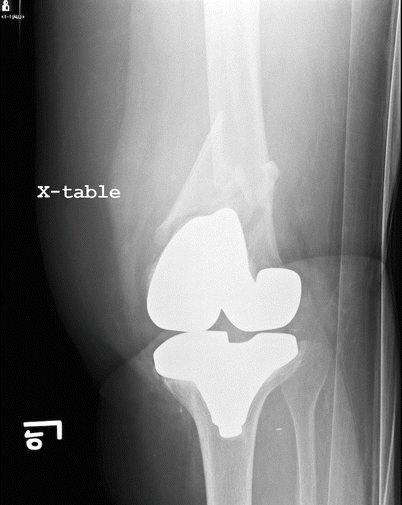

Fig. 30.12
AP knee X ray of a periprosthetic femur fracture above a knee replacement
The goals of treatment include restoration of alignment and early return to function Non-displaced, stable supracondylar femur fractures can be managed non operatively in low-demand patients [178]. Operative fixation gives the advantages of immediate range of motion, earlier weight bearing and less risk of late displacement. All displaced distal femur fractures are indicated for surgical stabilization.
Displaced fractures can be treated with either lateral locked plating (Fig. 30.13) or intramedullary nailing. Results were similar in a comparison of a small group of patients [179].


Fig. 30.13
AP knee X ray of fixation with lateral plating of a periprosthetic femur fracture
Intramedullary nailing of these fractures is challenging. Meticulous pre operative planning is necessary, as the surgeon must be familiar with the type and dimensions of the implant to ensure that the nail will pass [180]. There must also be enough bone stock in the distal segment in order to support the interlocking screws. In addition, placement of additional fixation (i.e. blocking screws) may be necessary in order to achieve and maintain alignment [24].
Lateral locked plating has also been reported to successfully treat these fractures [181]. Because of osteoporotic bone, supplemental fixation may be necessary to help avoid varus collapse (Fig. 30.13). Unfortunately, supracondylar femur fractures have a high re-operation rate due to delayed or non-union of the fracture [182]. In a large study of 335 patients, 20 % required secondary surgery to promote union. Diabetes, open fracture, smoking, increased BMI >30 kg/m2, and shorter plate length were predictors of reoperation for union and other complications.
If the implant is loose, revision total knee surgery is required. This surgery is technically challenging, and is often best accomplished by an experienced arthroplasty surgeon. Revision involves not only fixing the fracture, but ensuring stability and alignment to the knee [178].
Upper Extremity Fractures
Although upper extremity fractures in the elderly are not typically life-threatening, the resultant impairment may be so functionally debilitating that the injured patient can no longer manage independently. The majority of such upper extremity fractures may be treated non-operatively. However, the physician must be aware of the potential consequences of prolonged immobilization on the entire limb. Locking plate technology is particularly suitable for providing stable fixation in poor bone, permitting early mobilization and functional recovery.
Distal Radius Fractures
Distal radius fractures in the elderly are quite common. The incidence rate increases with age, and is highest in patients 80 years and older. These typically occur as isolated, low energy injuries resulting from a fall onto the outstretched hand. However, a neurovascular examination is essential, focusing on the median nerve. Preexisting carpal tunnel syndrome may be exacerbated by the energy of injury and/or the displacement of the distal radius. Concomitant progressive or severe median nerve dysfunction is an indication for urgent carpal tunnel release; in such instances, the fracture is usually stabilized with plate fixation.
The method of treatment of displaced distal radius fractures in the elderly population remains controversial. While restoration of anatomy is a goal of treatment in the younger patient, the relevance of such an approach in the elderly is unclear. A prospective, randomized study [183] comparing closed reduction and cast treatment with open reduction and internal fixation using a volar locking plate demonstrated better grip strength in the operatively treated group; however, there was no difference in wrist motion, pain, or function at 1 year between the two groups. Although 78 % of non-operatively treated patients had a visible deformity (prominent ulnar head), none of them was dissatisfied with the clinical appearance or the result. The complication rate in the surgical group was 36 %, including tendon ruptures. Similar results have been reported retrospectively in an analogous patient population [184]. A systematic review concluded that, in spite of worse radiographic results with cast treatment, functional outcomes are equivalent to surgical repair of distal radius fractures in patients older than 60 years of age [185].
Interestingly, the patients treated surgically reported better function during the first 3 months following injury. This is not surprising, since non-operatively treated distal radius fractures are casted for approximately 6 weeks, whereas patients may be placed into a removable splint soon after plate fixation. This highlights the importance of patient factors in the decision-making process. Older patients who are living alone may be able to retain their independence if treated surgically.
When the decision is made to operate, a number of options are available for fixation. As a rule, percutaneous pin fixation is unreliable when the bone quality is poor. Volar locking plates, in which the screws thread into the plate itself, are ideal for managing osteoporotic fractures [186]. Equivalent results may be obtained with external fixation. Surgeon experience is a principal determinant in the type of implant selected.
Distal Humeral Fractures
One of the most challenging fractures to treat are articular fractures of the distal humerus, particularly in the setting of osteoporosis. With rare exception, these fractures require surgery. A 1984 study demonstrated good-to-excellent results in 76 % of operatively treated fractures compared with 9 % for those treated non-operatively [187]. These injuries require anatomic reduction and stable fixation in order to allow for early motion, as prolonged casting (>14 days) results in permanent stiffness. The advent of locked, pre-contoured plates has simplified the surgery to some extent. For the elderly, low demand patient, primary total elbow arthroplasty may be a better alternative.
The initial evaluation should include an assessment of associated soft tissue injuries, such as an open fracture, and neurovascular status, with particular attention to the ulnar nerve which rests in close proximity to the elbow joint. Ipsilateral orthopaedic injuries, such as fractures of the distal radius, are not uncommon; the entire limb should be examined and radiographed if necessary. History should include specific inquiry as to the pre-injury status of the elbow, since pre-existing arthritis may influence the decision-making process. Radiographic evaluation must include AP, lateral, and oblique views of the elbow; these may be difficult to interpret because of fracture displacement and patient positioning. On occasion, traction views performed in the emergency department may provide additional detail regarding the complexity of the fracture. Virtually all patients with distal humeral fractures will require a non-contrast CT scan of the affected elbow as an element of preoperative planning. In the absence of an open fracture, these injuries are managed semi-electively in order to ensure that appropriate equipment is available.
Surgical repair of distal humeral fractures involves multiple steps; on many occasions, exposure includes ulnar nerve transposition and olecranon osteotomy for exposure. Surgery is performed under tourniquet control to limit blood loss and enhance visualization. Typical fixation includes a minimum of two plates in order to maximize stability and permit early motion. Locking plates have decreased the likelihood of failure of fixation. Nevertheless, complications are not uncommon, and include ulnar nerve injury, stiffness, heterotopic ossification, and infection. Pain relief is fairly predictable, with one study reporting 83 % of patients having no or mild pain [188].
In the 1990s, dissatisfaction with the results of surgical repair of distal humeral fractures in the elderly using non-locking plates led Morrey to manage some of these injuries in a way analogous to femoral neck fractures –total elbow arthroplasty [189]. A more recent review of these patients at the Mayo Clinic showed an average range of motion of 24–132° and a high degree of patient satisfaction. The reoperation rate was 12 % [190]. Two distal humeral fracture studies comparing repair and total elbow arthroplasty in patients older than 65 years of age have come to similar conclusions [191, 192]. Elbow arthroplasty was associated with shorter surgical times, better elbow scores, less disability (as measured by DASH scores) than open reduction internal fixation. Range of motion was at least equivalent. However, given concerns about wear, the typical postoperative restrictions include lifting no more than 10 pounds as a single lift or 2 pounds repetitively with the affected arm. Consequently, total elbow arthroplasty is reserved for low demand, elderly patients with pre-existing arthritis or with comminuted low articular fractures with limited bone for fixation.
Proximal Humerus Fractures
In the elderly population, fractures of the proximal humerus typically are the result of a fall from standing height. These fractures are about half as common as hip fractures in this population, accounting for 10 % of fractures in people >65 years of age. Associated injuries, such as head trauma and rib fractures, should be excluded. Displaced proximal humerus fractures may be associated with neurovascular injury, including subclavian artery and brachial plexus injuries. If pulses are diminished, Doppler studies should be performed, and the blood pressure recording should be compared with the other arm. If the pulses remain altered following gentle realignment of the limb, an urgent vascular consult must be obtained. The neurologic status of the extremity may be difficult to assess due to pain; the examiner should check for altered sensation in the deltoid area to assess for axillary nerve dysfunction. Other relatively painless maneuvers include assessment of sensation in the median (index finger), radial (first web space), and ulnar (little finger) distributions and motor function, including elbow flexion (musculocutaneous), wrist and digital extension (radial), thumb flexion (anterior interosseous branch of median nerve), and ability to cross-fingers (ulnar).
Stay updated, free articles. Join our Telegram channel

Full access? Get Clinical Tree





